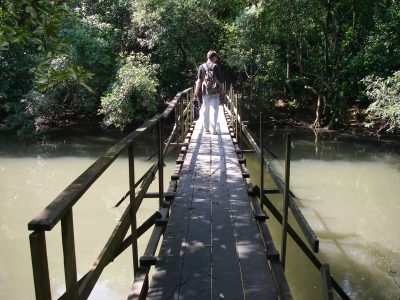Indeed, like what Samson mentioned in his blog, there are just too many things to see at Khabit Bongsu, and so I'll be havng a part two as well :)
We reached the dirt track which led to Khatib Bongsu around 7 plus in the morning, and the view was really stunning.
There were lots of native and exotic plants onboth sides of the dirt track, but being not much of a plant person, I can only identify some of them. Hopefully Luan Keng or someone else can help me to ID after reading this :P
Here's the fruit of the Simpor Air (Dillenia suffruticosa).
The leaves of the Simpoh Air were used to wrap food or made into into shallow cones to contain traditional food.
Can't remember the name of the trees below, though I understand it's an introduced species. The canopy was really pretty though.
We also found an eagle's nest (see below). Can't remember the species as well.
On the grasses and trees on the two sides of the roads were lots of insects and other little animals. Will cover them in my next entry. We walked all the way in and finally reach the mangrove area.
One of the first mangrove birds we saw this shy night heron. It's quite well-camouflaged though, but if you look carefully, you will be able to find it among the prop roots below.
Walking on, we reached one of the old kampong house which had been torn down. There were lots of lokan (Polymesoda expansa) shells on the ground among the broken tiles. Wonder what they were used for though. Or was it that the residents who used to live here ate a lot of lokan and just any how threw them around?
We also witnessed the tearing down of another kampong house. Kind of sad actually when you think about it actually. Many of the resdents are quite old and they have lived here for many years, and now, they have to move to some where else. Definitely won't be easy for them to get use to their new environment.
Another fish farm was still operating when we're there, though we knew its fate was already sealed as well. Soon, the residents will have to leave and the buildings will be demolished.
There were plenty of wild life here as well. We saw many fishes, inlcuding this giant mudskipper (Periophthalmodon schlosseri) below.
There were lots of mud lobster (Thalassina anomala)mound as well. The one below was still quite new, since it was so short. The mud looked fresh as well, so probably the mud lobster had just emerged from its burrow a short while ago to push out the mud.
When we walked towards the edge of the fish farm and looked across the river at the stretch of mangroves - it was a beautiful view. It just felt so peaceful and quiet here. We saw a few purple heron and a grey heron. They were too far away for me to take any photos though.
Finally, we decided to turn back. But even on the way back, we had a nice surprise waiting for us on a tree by the dirt track - a lizard.
This is probably a changeable lizard (Calotes versicolor), though since I'm no lizard expert, I also can't say for sure :P
Anyway, we eventually made our way over this shaky wooden bridge and headed back for Yishun.
But, that's not the end of our adventure for the day. After having our lunch, Samson brought us to this pet shop, and I was quite shocked by the things they sold there.
Colourful sea cucumbers, sea stars (including several archasters and 2 knobbly sea stars), lots of tube worms, moon snails, marine fishes, and even several nudibranchs (2 species of chromodoris, a jorunna, and another 2 which looked suspiciously like spanish dancers)! I even found a white-coloured egg ribbon in one of the tanks!
Very depressing to see them in a pet shop actually. Sigh...
I just hope that after our various talks and walks, more Singaporeans will be aware of the conservation issues and stop keeping marine animals as pets. Then hopefully these marine pet shops will have to close shop.
Sunday, April 15, 2007
Khatib Bongsu
Subscribe to:
Post Comments (Atom)


3 comments:
The reason we brought it up is not to advertise, but to highlight how fragile the marine creatures is with us around. If you thinking of buying one for your tank(s), you might want to know that nudibranchs and lots of other marine creatures uses chemical defence to deter predators. In open sea, this probably serves only to irritate, but in an enclosed space like aquarium. it could kill all the inhabitants!!!
Yea, I agree with that. My friend once bought a cone shell to add to her aquarium but it stung her favorite clownfish to death.
She should be thankful that the cone shell didn't sting her to death.
Post a Comment